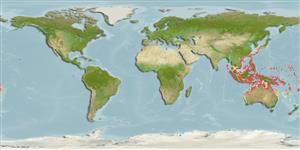Classification / Names
Common names from other countries
Main reference
Size / Weight / Age
Max length : 3.5 cm SL male/unsexed; (Ref. 48637)
Environment
Marine; demersal; depth range 17 - 35 m (Ref. 40966)
Climate / Range
Tropical, preferred ?
Distribution
Indo-West Pacific: Malaysia to Philippines north to Japan, south to Australia.
Countries | FAO areas | Ecosystems | Occurrences | Introductions
Short description
Dorsal
spines
(total): 6 - 7;
Dorsal
soft rays
(total): 7-9;
Anal
spines: 1;
Anal
soft rays: 8 - 9. Characterized by semi-transparent body with fine dark speckling; side of snout with brown stripe; internal brown, dash-like markings with white or yellow pigment along dorsal edge of vertebral column; longitudinal scale series 24-27; scaled head and nape; restricted gill opening to pectoral fin base; depth of body at anus 5.0-7.7 in SL (Ref. 90102).
IUCN Red List Status (Ref. 115185)
Threat to humans
Harmless
Human uses
More information
Common namesSynonymsMetabolismPredatorsEcotoxicologyReproductionMaturitySpawningFecundityEggsEgg development
Age/SizeGrowthLength-weightLength-lengthLength-frequenciesMorphometricsMorphologyLarvaeLarval dynamicsRecruitmentAbundance
ReferencesAquacultureAquaculture profileStrainsGeneticsAllele frequenciesHeritabilityDiseasesProcessingMass conversion
Tools
Special reports
Download XML
Internet sources
Estimates of some properties based on models
Phylogenetic diversity index
PD50 = 0.5000 many relatives (e.g. carps) 0.5 - 2.0 few relatives (e.g. lungfishes)
Trophic Level
3.2 ±0.3 se; Based on size and trophs of closest relatives
Resilience
High, minimum population doubling time less than 15 months (Preliminary K or Fecundity.)
Vulnerability
Low vulnerability (10 of 100)
Price category
